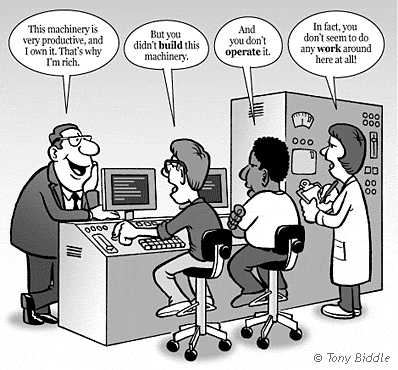Introduction: Why Study Economics?
The introduction explains why trade union members, community activists, and concerned citizens all need to learn more about economics, in order to challenge the false assumptions and underlying political agenda of conventional economic “experts.” It also provides an overview of the book, and an introduction to the many on-line resources that are available for free on this website.
Chapter 1: The Economy and Economics
This chapter provides a clear, non-technical definition of “the economy.” At its simplest, the economy is no more and no less than “all the work that human beings perform, in order to produce the things we need and use in our lives.” The economy is a shared place, and it is always shaped by our conscious social decisions: there is nothing “inevitable” or “permanent” about how the economy must function. This chapter also discusses how to measure the economy, and the imperfect relationship between economic output and human well-being.
Chapter 4: The Politics of Economics
This chapter provides a condensed overview of the history of economic thought, focusing on the links between the theories of various economists and the political debates which were raging at the time they wrote. No economist (least of all me!) is ever “neutral” or purely “scientific”; economics always reflects implicit value judgments, preferences, and vested interests. The chapter also introduces the approach that currently dominates most economic teaching and policy, called “neoclassical” economics, highlighting its own political roots and biased conclusions.
Chapter 10: Closing the Little Circle
This chapter provides the first of many cartoon “road maps” (drawn by Tony Biddle) that are used throughout the book to describe the major interactions and loops that compose the modern capitalist economy. In this simplest road-map (called the “little circle”), we explain how production under capitalism starts with an initial investment by a profit-seeking private company. Production and jobs result, and the resulting income is subsequently distributed (usually in a very unequal fashion!). Later maps add to this map (including the roles of government, the financial industry, the global economy, and the environment) to provide a full depiction of a capitalist economy.
